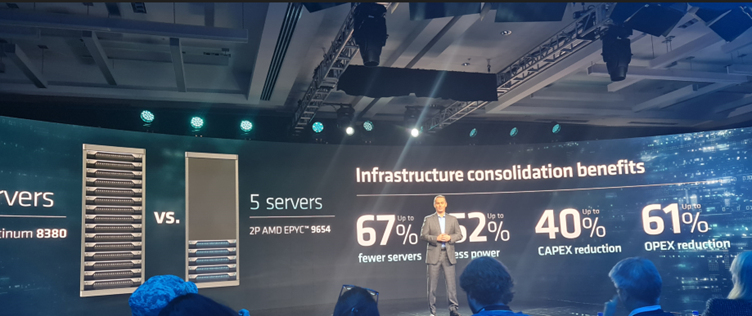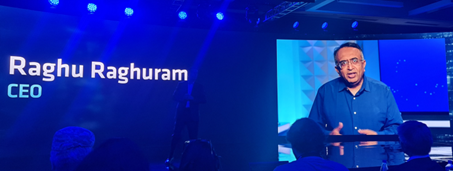
Data & Storage Asean were invited by AMD to cover the launch of the 4th Generation of their EPYC processor in San Francisco today (10th November 2022).
The session was led by Dr Lisa Su, CEO and Chair and AMD did an excellent job of spelling out two important things.
First, they are establishing themselves as the leader in data centre CPU offerings.
Next, with this 4th generation’s launch, they are making a fundamental leap which has a deep-reaching impact on everyone involved in running or managing technology.
Here’s a breakdown of the important aspects of the launch that IT professionals need to know.
Dr Su reminded us that choosing the right data centre CPU has never been more important, she pointed out how this is not limited to cloud providers and public data centres but applies to corporate IT running their own on-prem or hosted environments.
With this front and forefront, Lisa assured us that what was already the best server CPU just got even better. By every measure that matters the 4th Gen EPYC has extended its advantage over the competition.
For Lisa, whichever metric you look at, it all comes back to two things: Performance and efficiency. As you tuned in to what AMD’s CEO was saying there was a third key takeaway that she wanted us all to hear, and that is the investment in security they have built into EPYC.
AMD Chair & CEO Dr Lisa Su holding a 4th Gen EPYC CPU– over 90 billion transistors in the palm of her hand!
On the question of power and efficiency, AMD has really managed to “square the circle” in a way that impresses analysts and systems builders alike. The challenge of delivering more power per core whilst reducing energy consumption is a tough one but according to Dr Lisa AMD has met this challenge.
She went on to explain why this matters to us all, and in simple terms, it’s about the nirvana that everyone working in IT always wants – To achieve more with less. In this case more computing power, less cost, less power, and less data centre space.
Dan McNamara, GM of AMD’s Server Business Unit, added some examples to show the real-world implication of the technical advances in the chip.
With like-for-like workloads, moving to a CPU powered by 4th-Gen EPYC will result in measurable consolidation benefits. Dan provided numerous examples including database, HPC and Virtualisation, and the net was always similar. Significant consolidation benefits include more than 60% fewer physical servers, 50% less power consumption, and massive decreases in opex and capex spending.
When you redefine the economics of data centre computing in such a fundamental way, anyone involved in managing IT needs to sit up and take notice. Dan made the argument that you are in danger of being left behind if you don’t start upgrading to this the new level of power and efficiency.
 Dan Mcnamara GM of AMD’s Server Business Unit shares the numbers that are redefining the economics of Datacentre computing
Dan Mcnamara GM of AMD’s Server Business Unit shares the numbers that are redefining the economics of Datacentre computing
Both Dr Lisa and Mark Papermaster, CTO of AMD went to great lengths to assure us, that this new leadership position is not for the short term. According to Mark, AMD is far from “using all the tricks in the book,” and we can expect a steady flow of continuous improvements.
No doubt reading this you can be forgiven for thinking, “Well AMD would say all this wouldn’t they,” so to add credibility to their claims they brought on senior execs from an array of cloud providers and system builders to endorse the message.
Of course, this is nothing new, we see this as standard fair at most product launches but from my viewpoint the endorsements on this occasion were meaningful. They carried weight and gave a very strong backing to the big claims. What is clear, is that AMD’s position with these companies has changed. In the past, they might have paid lip service to what they considered as a second source supplier but the dynamic is different now, quite clearly these companies see AMD as their major CPU partner. It’s a noticeable step change.
So who said what?

Scott Guthrie – Microsoft EVP Cloud and AI group.
“We are seeing an 80% performance improvement on AI workloads with the 4th Generation EPYC.”

Clay Magouyrk – Oracle EVP Cloud Infrastructure.
“We used to ask Why AMD? Now we say Why Not AMD? Exadata runs on EPYC, it’s a case of choosing the right processor for the job.”

Antonio Neri – HPE CEO.
“HPE is adding 6 new platforms using the 4th Gen AMD EPYC with increased governance and security as well as targeted workload performance.”

Amin Vahdat – Google Cloud VP & GM Systems and Services Infrastructure.
“4th Gen is helping us with our renewable energy aspirations to remain as the cleanest public cloud. It’s also key to our confidential computing offerings.”

Raghu Raghuram – VMware CEO.
“VSphere 8 is optimised for the 4th Generation EPYC, delivering hyper-optimised performance with the lowest TCO and power consumption.”

Arthur Lewis – Dell COO Core Business Operations.
“AMD has designed incredible 1 and 2 socket solutions which support up to 50% more cores giving the highest performance in server compute today, we are seeing cases of 120% improvement in performance.”

Kirk Skaugen – Lenovo EVP & President Infrastructure Solutions Group.
“We have a deep collaboration with AMD and a deep engineering relationship, an important factor in our position as number one for reliability.”
 Charles Liang – Chair and CEO of Supermicro.
Charles Liang – Chair and CEO of Supermicro.
“AMD’s 4th Gen EPYC’s incredible power saving efficiencies are helping us with our green mission to save 8 billion trees.”
After the session, I managed to track down AMD’s Ram Peddibhotla (VP of product marketing) and asked him “Hey great endorsements but what about the Asian cloud providers, are they working with you too?” Ram confirmed that both Tencent Cloud and Al Cloud are both parts of the partner ecosystem and already building offerings on EPYC 4th gen.
As the keynote presentations wrapped up, Forrest Norrod, AMD’s GM for the Data Centre Solutions Business Group, who had been hosting the guests from Lenovo and the like pointed out that with one single 4th Gen EPYC server being able to replace 5 legacy servers, anyone anywhere who runs servers should really be thinking about whether it’s a business risk NOT to upgrade to this new gen of CPU.
The final words went to Dr Lisa, who rounded up the roadmap that is on the way, proudly reminding us how AMD delivers on their roadmap like clockwork.
 Dr Lisa presents roadmap
Dr Lisa presents roadmap
Her parting shot, the data centre is getting increasingly complex and will require optimised processing for custom workloads, and there is no company you can rely on more to deliver this solution on time and with leading performance than AMD.
You may be buying fewer servers and more “as-a-Service,” but it’s time to make sure you understand how the processor landscape will affect how your service providers operate.




